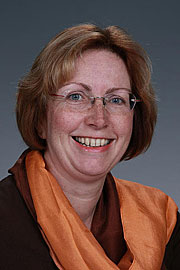- Number 333 |
- March 21, 2011
PNNL’s Kleese van Dam makes sense of the data landscape
On long walks in the desert near Richland, Wash., it’s easy for Kerstin Kleese van Dam to imagine the vast expanses of sagebrush and tumbleweeds as immeasurable points of data stretching to the horizon. It’s a notion with which she is familiar.
“There is so much data coming at us from all directions that it has become difficult to make sense of it all. Our challenge is getting as much usable knowledge from this data as possible,” said Kleese van Dam, head of the Scientific Data Management Group at DOE’s Pacific Northwest National Laboratory and a leader in the Lab’s new Chemical Imaging Initiative. “And it is just as important to make that data-based knowledge more widely available to the research community to help drive science forward.”
A native of Germany and graduate of the Berlin Institute of Technology, Kleese van Dam started her career in high-performance computing in the automotive industry, but soon transitioned to climate modeling in Germany and the United Kingdom. “I quickly came to realize that our major challenges were not on the computational side, but in data management and knowledge discovery, and so I concentrated on those issues more and more,” she said. “Interest in our data management developments grew, and soon we were working with many different science domains. One key data-intensive science area was the management and exploitation of data from large-scale experimental facilities. We built an integrated infrastructure for them, which is now used by numerous facilities around the world.”
Kleese van Dam joined PNNL in 2009 and brought with her a long list of credentials, including co-authoring more than 100 publications. She has served as a reviewer for DOE's Scientific Discovery through Advanced Computing SciDAC program, the UK Biotechnology and Biological Sciences Research Council, Natural Environment Research Council Peer Review College, and Particle Physics and Astronomy Research Council Data Curation Review Panel. She was also a member of the Institute for Environmental e-Science Advisory Committee and Open Middleware Infrastructure Institute Technical Advisory Board. Presently, she is a member of the International Committee for Future Accelerators Study Group on Data Preservation for High Energy Physics and the DataOne Semantic working group.
Today, Kleese van Dam and her PNNL colleagues are focused on helping scientists take advantage of available data and pull from it the knowledge they need for their research. “The goal of our work is to ‘connect the dots’ for researchers – to provide visibility to the results of similar work generated with different technologies at different research organizations,” she said, noting that data includes more than text; it includes numerical results, data tables and, microscopy, and other images.
While data volumes continue to grow, Kleese van Dam says laboratory technology is becoming more and more sophisticated, forcing scientists to become increasingly specialized and unaware of other data that may move their research forward. A solution, which many of her publications address, is comprehensive data integration.
“A PNNL researcher, for example, may be investigating a particular catalyst using a specific method,” she said. “Another scientist at a different lab, meanwhile, may be doing similar work with different instruments. Often, these researchers will not have access to each other’s data. However, if they have online visibility to the data and are able to correlate and integrate their research, they can both move forward much more quickly.”
In the end, says Kleese van Dam, the goal is to make sense of the immeasurable points of sagebrush and darting tumbleweeds, and give researchers a comprehensive view of the landscape.
Submitted by DOE's Pacific Northwest National Laboratory

